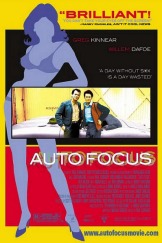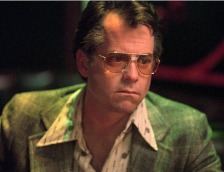|
Auto Focus
|
| |
 |
USA, 2002. Rated R. 104 minutes.
Cast:
Greg Kinnear, Willem Dafoe, Rita Wilson, Maria Bello, Ron Liebman, Bruce
Solomon, Michael Rodgers, Kurt Fuller, Christopher Neiman, Lyle Kanouse,
Ed Begley Jr, Michael McKean
Writer: Michael Gerbosi, based in part on the book The Murder
of Bob Crane, by Robert Graysmith
Music: Angelo Badalamenti, Andrew Barrett (additional music/orchestration)
Cinematographer: Fred Murphy
Producers: Scott Alexander, Larry Karaszewski, Todd Rosken, Patt
Dollard, Alicia Allain
Director: Paul Schrader
LINKS
|
 he
story of the modest rise and precipitous fall of television star Bob Crane (Hogan's
Heroes), Auto Focus is not your typical biopic. Like real life, biographies
are sloppy, lacking clear beginnings and endings, and replete with distracting
details that filmmakers include for the sake of completeness. In praise of Auto
Focus director Paul Schrader, who wrote Taxi Driver, Raging Bull,
and The Last Temptation of Christ, Martin Scorsese has said Schrader
possesses a talent for adapting difficult source material to the screen because
he unerringly hones in on the essence of the story and mercilessly strips away
everything else. Though Schrader does not have a screenwriting credit on Auto
Focus, its source material (The Murder of Bob Crane, by Robert Graysmith)
is adapted with Schrader's same instinct for what is important and what is not.
he
story of the modest rise and precipitous fall of television star Bob Crane (Hogan's
Heroes), Auto Focus is not your typical biopic. Like real life, biographies
are sloppy, lacking clear beginnings and endings, and replete with distracting
details that filmmakers include for the sake of completeness. In praise of Auto
Focus director Paul Schrader, who wrote Taxi Driver, Raging Bull,
and The Last Temptation of Christ, Martin Scorsese has said Schrader
possesses a talent for adapting difficult source material to the screen because
he unerringly hones in on the essence of the story and mercilessly strips away
everything else. Though Schrader does not have a screenwriting credit on Auto
Focus, its source material (The Murder of Bob Crane, by Robert Graysmith)
is adapted with Schrader's same instinct for what is important and what is not.
Auto Focus is not the story of making of Hogan's Heroes, an improbably
successful situation comedy about clever Allied prisoners and their slow-witted
German captors in a World War Two POW camp, and its six-year run on CBS (1965-1971).
Not that the show's tale is uninteresting. Despite its popularity, it was named
one of the fifty worst television shows of all time (#5 on the list) in a recent
TV Guide feature. Auto Focus does not ignore Hogan's Heroes;
in fact, it recreates the show in uncanny detail with actors who nail the characters
impeccably, particularly Ron Fuller as Werner Klemperer, a.k.a. Colonel Klink.
The core of Crane's story is something else entirely. Crane was a man addicted
to sex, so much so that it cost him career and possibly his life. To document
his exploits, Crane and his partner in crime, John Carpenter (Willem Dafoe,
a frequent Schrader collaborator), pioneered video pornography. Though he hid
his lifestyle from his first wife (Rita Wilson), visitors to Crane's home in
later years were apt to be subjected to his photo albums bursting with nude
Polaroids or extensive library of amateur home videos.
Auto Focus doesn't resemble an addiction movie any more than it looks
like a biopic, however--at least not the films about addiction that normally
leap to mind, including Schrader's own Affliction. Auto Focus
does not set out to be one of those message movies with histrionic acting and
didactic homilies about the dangers of overindulgence. The film never even mentions
the word "addiction." Crane, in fact, is nothing like your typical movie addict.
Clean cut and conservatively dressed (sweaters with khakis or polyester pants),
Crane seems to be the sort of guy mothers wish their daughters would bring home.
He rarely drinks, usually sticking to grapefruit juice.
Most actors think they're supposed to kick up a storm when they play addicts.
Kinnear, an inspired choice to portray Crane's casual likeability, presents
Crane simply as a man who doesn't get it. A day without sex is a day wasted.
Sex is the most natural thing in the world, isn't it? If people don't understand
that, obviously there is something wrong with them, not with him.
Crane's priest tells him he must remove himself from temptation in order to
avoid it, yet Crane repeatedly fails to do this. His fame enables him to attract
women, and Crane shamelessly uses it to his advantage. Then there is his relationship
with Carpenter--two men enabling each other's conduct, doing things they might
never do alone. In a bit of dramatic license, Auto Focus makes Carpenter
and Crane seem inseparable. That does not correspond to the truth, Schrader
admits, but he sees their friendship as the centerpiece of Crane's life nonetheless.
Carpenter is Crane's most enduring relationship, the bond with Carpenter the
only one Crane is able to maintain. Crane is so walled off from everyone else
that he can't even sustain a marriage (his second) to a woman who doesn't mind
his sexual escapades, Patti Olson (Maria Bello), stage name Sigrid Valdis, who
played Klink's secretary Helga beginning with Hogan's second season.
In the grip of addiction and totally self-focused, Crane is not the least bit
aware of what his habit is costing him. Crane is carried away until he loses
touch with everyone and everything. Only at the end are there glimmers of insight.
He has a weird conversation drawn from real life with his son, Bob Crane Jr.
(who served as technical advisor and appears in the film as an interviewer for
a Christian publication), about reconnecting with basic things, in which he
bizarrely discusses the true meaning of the word "orange." But time runs out.
Writing for Scorsese and for other directors (The Mosquito Coast, Patty
Hearst, Obsession), Schrader has made a career of examining obsessive characters
with distorted perceptions of reality. He has continued these explorations in
directing his own films, with mixed results. Affliction won an Oscar™
for James Coburn; The Comfort of Strangers was one of the worst films
of the last fifteen years. (Other directorial credits include American Gigolo,
Blue Collar, and Cat People.) Unquestionably among the successes,
Auto Focus is perhaps Schrader's most sophisticated film to date. Instead
of hitting the audience over the head with a moral, Schrader relies on subtle
ironies and visual devices to convey point of view. For example, the film opens
with Crane, working as a morning radio deejay in Los Angeles, interviewing Clayton
Moore, better known to television audiences as the Lone Ranger--a masked man,
whose true face no one knows, and whose partner, incidentally, is a Native American,
just like Carpenter is part Native American. Then, to represent Crane's rapport
with the women in his life, there's the oft-repeated punch line from Crane's
touring dinner-theater play, Beginner's Luck, from which he earned a
living for much of the Seventies. Crane gazes out a window, and in response
to a query whether he sees his wife, he exclaims, "I don't know! What does she
look like?" Every time Schrader shows us this scene, Crane is playing opposite
a different female lead.
With regard to the visual elements, Schrader gradually degrades the quality
of the film to mirror the degeneration of Crane's life. "My visual strategy
was rather simplistic," says Schrader, "It is just an arc from clean lines to
clutter, an arc from stable cinematography to shaky cinematography. An arc from
saturated color to de-saturated color. So it's just a whole gradual arc, the
world becoming less stable, less predictable."
Certainly no one could have predicted that a biography of a minor, forgettable
television star could be such an absorbing, compelling, and even frightening
film about compulsive behavior and unhealthy relationships. Perhaps it is because
Schrader did not set out to make a film about addiction per se, but rather,
a movie about a self-deluded, self-enabling man whose rise and fall were both
entirely of his own making.
Review
© October 2002 by AboutFilm.Com and the author.
Images © 2002 Sony Pictures Entertainment, Inc. All Rights Reserved.


